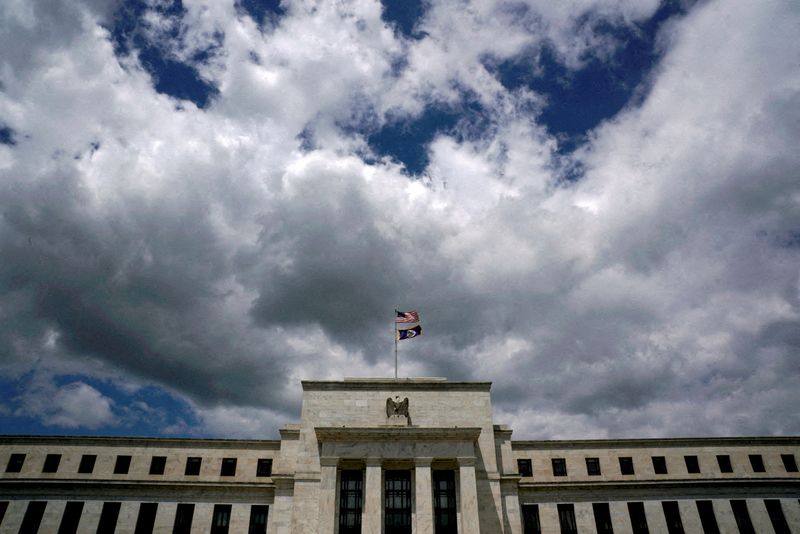By Ann Saphir
(Reuters) - U.S. central bankers are not expected to cut borrowing costs this week, but their new economic projections may be a wild card, potentially signaling fewer interest rate cuts and a later start to the policy easing than they previously had estimated.
Keeping interest rates at the current high levels for a longer period of time could have big implications for American households and businesses, especially in a presidential election year when the state of the economy is already a central talking point for President Joe Biden and his Republican challenger, Donald Trump.
Market bets still point to the Federal Reserve's June 11-12 meeting as the most likely start for reductions to the central bank's policy rate, which has been in the 5.25%-5.50% range since last July.
But with inflation still running well above the Fed's 2% target and coming in stronger than expected in the first two months of this year, traders are pricing a 40% chance that the first rate cut only happens at the July 30-31 meeting.
Bets in financial markets also point to an end-of-2025 policy rate in the 3.75%-4.00% range, a quarter of a percentage point lower than Fed policymakers forecast in December.
"Two months (of higher inflation readings) is too soon to declare that all is lost, but it certainly raises the risk that you have a little bit more of an inflation problem, and in that case it makes sense to be cautious," said Jeremy Schwartz, senior U.S. economist at Nomura Securities. "You have to consider the possibility that it will take a longer period of restrictive policy."
Nomura is among a minority but growing number of forecasters who believe Fed policymakers this week will trim the number of their anticipated rate cuts this year to just two quarter-percentage-point moves, from the three that U.S. central bankers projected in December.
A report last week showing consumer price inflation accelerated to 3.2% in February from 3.1% in the prior month is not going to give Fed policymakers greater confidence that inflation is moving sustainably toward their 2% goal, the bar they set in January for cutting rates.
"They were hoping for better, clearly ... but I'm not sure they are completely surprised by this," said Kathy Bostjancic, chief economist at Nationwide, who is among those who think Fed policymakers will stick to the quarterly forecasts issued in December.
"I think it probably just validates their view that, yes, it's prudent to wait and see."
Despite signs of cooling, the economy remains strong. The unemployment rate, at 3.9% in February, is up two-tenths of a percentage point from the start of the year but still below what Fed officials believe is sustainable in the long run. Businesses added 275,000 jobs last month.
"The main message from them is, they can be patient," said Oscar Munoz, chief U.S. macro strategist at TD Securities.
If the median expectation for this year does shift to two rate cuts, Munoz said, it would suggest they see the recent stronger inflation readings as a "game changer."
Munoz expects the Fed to start cutting rates at every other policy meeting - or once every quarter, which he said implies a likely delay in the start of the policy easing to September if the central bank reduces the number of rate cuts in 2024 to two.
Either way, Munoz expects policymakers to project a slightly higher inflation rate for 2024, perhaps 2.6% by the Fed's preferred inflation measure, the personal consumption expenditures price index, up from 2.4% in December.
BALANCE SHEET
Deutsche Bank economists likewise see an upside risk to the Fed's inflation forecast, and like Munoz they expect the Fed on Wednesday to stick to the projection of three rate cuts for this year, with a start in June. But they also believe sticky inflation likely means central bank policymakers will trim the number of rate cuts they forecast for 2025 to three, from the four seen in December.
"The main message from the March summary of economic projections should be that the Fed will have little tolerance for further upside inflation surprises, and if they were to occur, expectations for policy easing this year will be dialed back (all else being equal)," they wrote.
Other economists caution against reading much at all into the median projections.
Gregory Daco, chief economist at EY, expects the median forecast for rate cuts to downshift to two on Wednesday, but for a resumption of softer inflation readings to require a total of four reductions in borrowing costs this year. By contrast, Tim Duy, chief U.S. economist at SGH Macro Advisors, argues that as many as eight of the Fed's 19 policymakers could pencil in fewer cuts than they did in December without shifting the median.
Most analysts expect few changes to the Fed's policy statement on Wednesday, but they see more of an emphasis on the need for "careful" adjustments in Fed Chair Jerome Powell's post-meeting press conference and plenty of hedging around the timing of rate cuts.

Many market participants are also hoping Powell provides a better sense of when the Fed could eventually stop shrinking its roughly $7.6 trillion balance sheet.
To be ready to announce the details of that plan in May and begin slowing reductions in June, as Yelena Shulyatyeva, senior economist at BNP Paribas (OTC:BNPQY), predicts is the likely timeline, "they need to do a lot at this meeting," she said.